Loy Kratong On The Onnut Klong / Review Toshiba A505 Laptop

|
• Iris Hotel Canakkale • Kolin Hotel • Tusan Hotel Canakkale • Sheraton Cesme Hotel Resort & Spa |
Thank you for your generous contributions. We're slowly collecting enough images to make the mosaics. I realize I'm posting the same paragraph each week, but I assure you we're on top of this project and doing our best to collect enough of the proper type of images to make the best possible set of mosaics. This is proving difficult so please help if you can.
We are still accepting (and pleading for) images of children from SEA. No matter how terrible you think they are, please send them in anyway. These images will be used to complete a set of 3 high quality mosaics which will be sold to benefit the Karen and Burmese Orphans living in the orphanages and refugee camps. The more images the better, I can use all you have. Please take the time to go through your images for anything you think might help. If you missed the "No Place to Call Home" special, you can click on the link and read more about this. Thank you! QandA@Bkkimages.com
Feature Photograph

Canon 1ds Mark II, 70-200mm F2.8 IS F4.5 1/125th ISO 400 Quantum Strobe
Context. The context of an image often makes the image much more significant. This is why "photo journalism" works so well. An image that won't draw interest on it's own, is suddenly
very interesting when coupled with a story. A story that might not draw much interest on its own, becomes a hit when illustrated with a powerful image. Journalism and Imagery goes together like chocolate and peanut butter. Photojournalism.
This image was captured during the Loy Krathong festivities when everyone was upbeat and happy. Throngs of people together, laughing, music, launching krathongs, drinking, a great time for all. Except this man. I failed to catch his face but he wasn't
at all happy. He was walking away from the festivities with a look of sadness only a terrible tragedy could produce. Neither drunk nor sober, he turned on his heel and strode away from the merry makers with purpose. The scene, fading from light
to darkness, a lonely path, and the bottles with candles lined up at attention like soldiers.

Unprocessed
At first I didn't like this image as captured. It didn't seem to have the proper life/impact. It felt cold and had far too much detail for the subject matter. Then I processed it with a product we'll be reviewing soon, and it gives a sort
of animated or oil paint(ish) look. And to me, the image came to life. This image is significant because it's chocolate and peanut butter, a lonely sad man and nearby festivities, a dull uninteresting "negative" and a warmer more 'life' image. It's significant because as the artist we have that much control. The worst looking images with no apparent life or purpose can tell a story and become warm
and full of life. It's up to you..

Canon 1ds Mark II, 70-200mm F2.8 IS F5.6 1/125th ISO 400 Quantum Strobe
I could have processed this next image, and the first, in Photoshop, but the product I've been reviewing will make this sort of thing possible without the Photoshop skills. This is almost a "cartoonish" look. The boat motor stands out against the dark night sky and the swimmer in the water collecting krathongs is lit to the same level. I've never been a fan this sort of look, and maybe it's just because I've refined my techniques
and therefore the look, but this look is starting to grow on me. I can visualize these images on a nice textured matte paper mounted on the wall.

Canon 1ds Mark II, 70-200mm F2.8 IS F4.5 1/125th ISO 400 Quantum Strobe
The last two images have been dark, but the image above has a lot more color and depth and looks even more like a brushed painting. I've still got a ways to go refining my technique, small differences in technique can affect the entire look. This
is fun and the resulting images appear to please many. There is a lot to be said about stripping much of the detail from an image and leaving it with just the essential lines, shapes, colors and feeling.
Loy Krathong on the On-nut Klong
On the night of the full moon on the 12th month of the Thai lunar calendar, arguably Thailand's best holiday of the year takes place. The "Krathong" is about 10 inches in circumference and
traditionally made from a section of a banana tree trunk and decorated with banana leaves, flowers, and candles. Often small coins will be placed in the center. In addition rafts and khom fai's will be launched in the river and air respectively.
Aside from venerating Buddha.. the release of the krathong symbolizes releasing your grudges and hard feelings. Anger disappears down the river with the krathongs journey down the river, or into the night sky with the khom fai. You'll see Thai people
either reading from a paper they made up listing all which they wish to cover, or just bowing their heads in a silent prayer immediately before releasing their krathong.
On this full moon of the 12 month on the Thai lunar calendar we met up with some good friends, drove to the klong where our boat and boat captain was waiting, and minutes later we're in the water away from the crowds and now afforded a perspective
you won't see if you're not on the water. The perspective of facing the people head on as they launch their krathongs, and the unforgettable perspective of life on the klong as we drive by klong home after klong home, kilometer after
kilometer. Each home is unique, some are a work of art, and the one thing they all have in common is the wonderful "Thai cheer" as they meet in groups to enjoy this holiday. It's impossible
to pass by a gathering without either being invited to join them, or being greeted warmly as you pass.

Canon 1ds Mark II, 70-200mm F2.8 IS F5.6 1/125th ISO 400 70mm Quantum Strobe
Khom fai's (floating lanterns) are released in the thousands in parts of Thailand, but in Bangkok you'll have to look hard to see one released.

Canon 1ds Mark II, 70-200mm F2.8 IS F8 1/125th ISO 400 70mm Quantum Strobe
Entire families read a list of their grudges and a prayer for the new year in a display of solemn family time you might not see for the rest of the year.

Canon 1ds Mark II, 70-200mm F2.8 IS F4 1/125th ISO 400 148mm Quantum Strobe
Small children are encouraged to float their own krathong as they're raised in the Thai culture. They'll often spend time decorating the krathong themselves, or working in a "krathong assembly line",
which you'll see many of.

Canon 1ds Mark II, 70-200mm F5.6 IS F4.5 1/125th ISO 400 130mm Quantum Strobe
Couples and newlyweds launch their own krathongs. I was very happy to see Styrofoam only occasionally this year. Last year the klongs were literally plugged up with thousands of Styrofoam krathongs that needed to be fished from the klongs and disposed
of.

Canon 1ds Mark II, 70-200mm F2.8 IS F6.3 1/125th ISO 400 85mm Quantum Strobe
Life along the klong is relaxed and friendly. You'll see many of these "cabana's" placed in most every property. As you pass by in your sampan they'll invite you over or cheer you
on your way.

Canon 1ds Mark II, 70-200mm F2.8 IS F5 1/125th ISO 400 175mm Quantum Strobe
Teenage girls launching small personal krathongs are a common sight, the young boys choose to drink and smoke and aren't at all interested in the krathongs or the holiday itself.

Canon 1ds Mark II, 70-200mm F2.8 IS F8 1/125th ISO 400 140mm Quantum Strobe
Beauty and talent contests for the younger boys and girls are part of every Loy Krathong venue. Small girls made up to look the part. This little girl caught my interest because she looks like a younger carbon copy of my wife.

Canon 1ds Mark II, 70-200mm F2.8 IS F5.6 1/125th ISO 400 165mm Quantum Strobe
You don't see a lot of elderly launching krathongs. You'll see them as part of family groups, but not often will the launch their own krathong. It's interesting to watch as their technique will be somewhat more polished and formal than
the others.

Canon 1ds Mark II, 70-200mm F2.8 IS F5.6 1/125th ISO 400 105mm Quantum Strobe
As you pilot the sampan up the klong you'll need to be mindful of the many young boys silently swimming in the dark as they search for krathongs and the few small coins in the center. And then in some areas they'll be quite open about it which
I gather isn't appreciated by many Thais.

Canon 1ds Mark II, 70-200mm F2.8 IS F5.6 1/125th ISO 400 78mm Quantum Strobe
I work really hard to achieve candid captures, but every now and then a pretty young girl will notice the big camera and beam her best smile your way.

Canon 1ds Mark II, 70-200mm F6.3 IS F4.5 1/125th ISO 400 95mm Quantum Strobe
Official security patrols in inflatable rafts will be seen putting out "small fires" as they slowly make their way up and down the klongs.
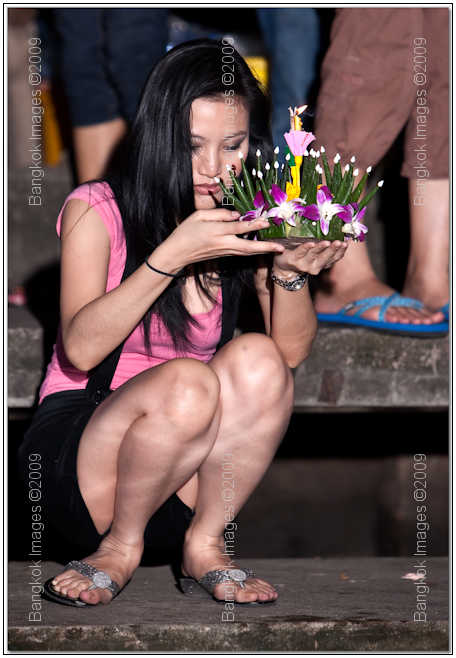
Canon 1ds Mark II, 70-200mm F2.8 IS F4 1/125th ISO 400 195mm Quantum Strobe
A single girl. I watched her walk from a small empty soi into the crowds by the klong and then to the waters edge to launch her krathong. Her prayer took longer than most. When she was finished and her krathong was floating down the klong, she quietly
stood and cleared the area as quickly as when she came in. She wasn't here to party or enjoy the festivities. She let some serious feelings go and then left.
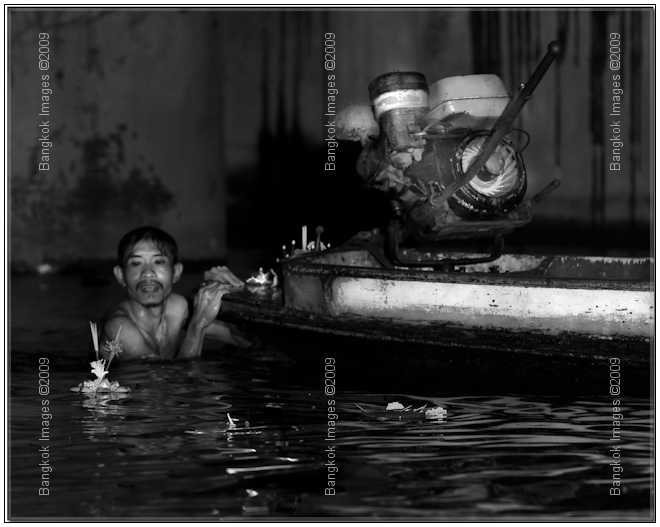
Canon 1ds Mark II, 70-200mm F2.8 IS F5.6 1/125th ISO 400 200mm Quantum Strobe
The rewards of the krathong coins can be significant as witnessed by this older man and his sampan floating mostly hidden under an overpass bridge as he swims for krathong after krathong. He didn't want anyone to see him and he'd selected a
great location in a very quiet place where many krathongs funneled.
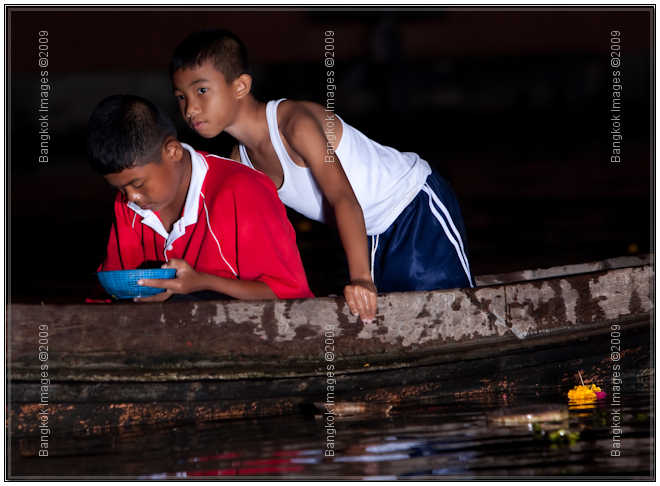
Canon 1ds Mark II, 70-200mm F2.8 IS F4.5 1/125th ISO 400 200mm Quantum Strobe
These kids were working with the old man. They'd take the coins from his hands and place them in this blue grated bowl, and then count the coins and provide a running subtotal.
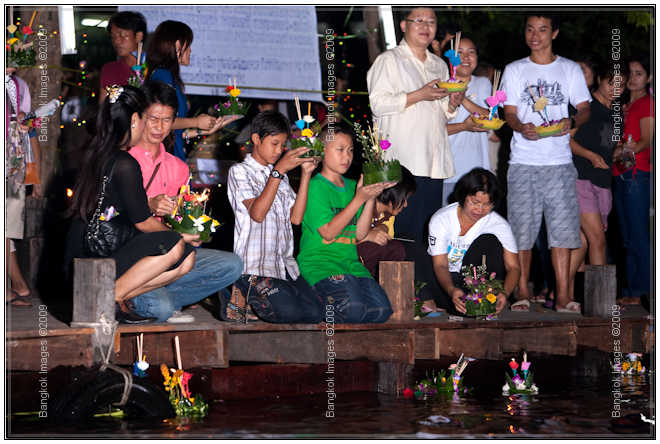
Canon 1ds Mark II, 70-200mm F2.8 IS F4 1/125th ISO 400 140mm Quantum Strobe
Here an entire family chooses to launch their krathongs together.
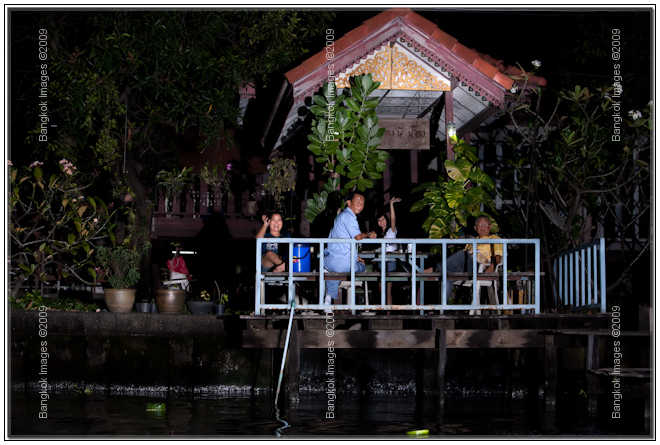
Canon 1ds Mark II, 70-200mm F2.8 IS F4 1/125th ISO 400 70mm Quantum Strobe
This is a nice example of a private gazebo like structure. Almost every home has something along these lines where they'll sit out to eat and drink most every evening. This is my fourth year studying the same klong and I find the lifestyle relaxed
and quite enjoyable.
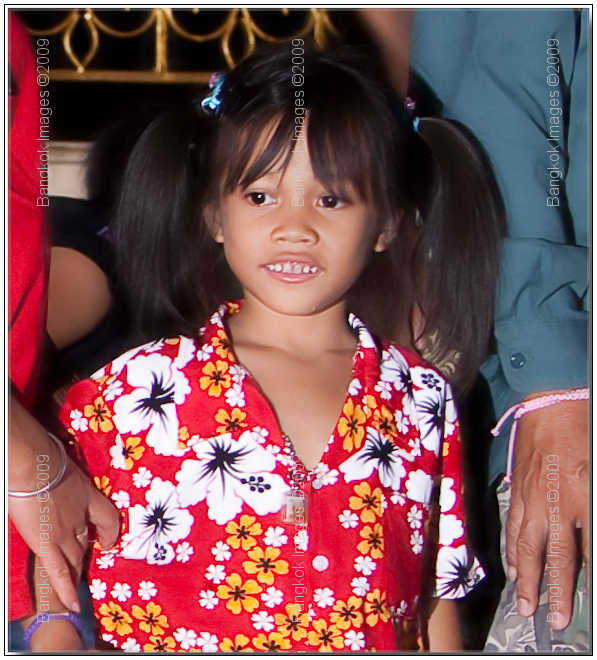
Canon 1ds Mark II, 70-200mm F2.8 IS F4 1/125th ISO 400 70mm Quantum Strobe
Does she look like a female Buckwheat or what! I just couldn't resist making this capture.
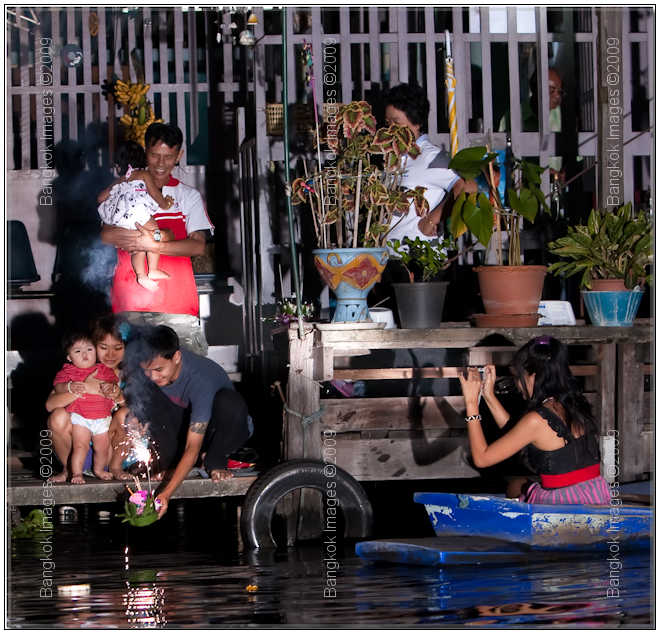
Canon 1ds Mark II, 70-200mm F2.8 IS F4 1/125th ISO 400 70mm Quantum Strobe
It appears I wasn't the only person out in a sampan taking pictures this great Loy Krathong evening. I'd started to take my huge powerful strobe for granted, but one look at this ladies tiny built in flash reminded me.

Canon 1ds Mark II, 70-200mm F2.8 IS F7.1 1/125th ISO 400 70mm Quantum Strobe
Would you be surprised to see krathongs funneled into a nearby temple and stripped of their coins under the direction of monks? I remember the first year, now on my fourth year I recognize some of them.

Canon 1ds Mark II, 70-200mm F2.8 IS F4 1/125th ISO 400 165mm Quantum Strobe
Cotton candy? I watched and captured this cute Thai woman and her cotton candy from a distance.
I hope you've enjoyed riding with us in our sampan along the On-nut klong. It's a great opportunity to see klong life up close and personal. The experience will stay with you forever. Take a stab at photographing the action and see how it turns
out. It's all fun!
A reader asked: "How did you make those captures in near darkness like those in the readers questions area last week?" This week I answer this question, but I'll be answering it in the readers questions section below. Don't miss it!
Review, Toshiba A505 Laptop
 I would like to introduce Craig Lamson.
I would like to introduce Craig Lamson.
Craig has been a professional product photographer for over 3 decades. Craig has done it all and I encourage you to check out his website for the best product photography you’ll ever have the privilege of viewing. Often times I can spend a great amount of time viewing just one of his images and learning while observing how he uses light. Craig is a master of light, and I’m afraid that is an understatement. If you've ever wondered who I go to when I have a question you now have your answer.
In search of the Holy Grail … a $750 laptop.
A review by Craig Lamson

"Enter here" copyright 2009 Craig Lamson
My laptop is so 2003. In today’s world, tech from 2003 is ancient. In ‘03 this was a state of the art $2000 desktop replacement loaded with the best goodies. Today it’s a boat anchor, but I can’t really complain. This Toshiba
laptop has been flawless and I’ve had it on shoots everywhere including lots of dirty and dusty factories. This computer has never missed a beat and in fact it went all these years on the original install of windows XP. (Upgraded of course)
So I tried to spruce it up a bit and I installed a new hard drive and did a clean install of XP. This helped but since this is my location computer system for shooting and processing Canon 1DsmkII files even a refresh could not save it.
I needed a new laptop.
The budget was small, only $750, so a top notch machine was out of the question. I had to find a machine with the most bang for the buck within that price range.
I plan on using this laptop for location photography shooting tethered to a Canon 1DSMKIII. That’s the main goal. But I also plan on using it to process files while away from home, work on my web pages, soon to be blog, surf the net and write my
spell-binding product reviews. Did I mention my spell-binding product reviews? In addition my wife will use this as her day to day computer since her current HP laptop is less than reliable.
Things I Wanted:
- A fast processor or at least the fastest I could afford
- 4 gigs of ddr ram upgradable to 8 gigs
- Vista 64 bit
- Standalone video card
- SD card slot (yes SD…I've been buying cheap mid level 16 gigs and using them in the MKIII)
- 16 inch screen
- Options…Bluetooth, back lighted keyboard, lots and lots of USB ports, long battery life.
Big Box Here We Come.
With a location photo shoot scheduled I needed the new laptop right away so I discarded the idea of buying online. While not buying online I did do considerable research on the net.
I had one brand that was off the list before even starting…HP/Compaq. My current backup laptop is a 16" Compaq made before Compaq was bought by HP and it's a decent machine and has never let me down. As I mentioned earlier, my wife has a current
HP laptop, purchased at a big box store. She was not looking for a powerhouse, just your run of the mill laptop. Frankly I think she picked it more for the looks and color more than anything, but it was her purchase so I mostly stayed out of it.
Sadly the thing locks up constantly, and I can’t find the fix. It’s out of warranty so we live with it, at least until now. She will be using the new laptop when it’s not on a shoot.
Given the big box requirement that leaves Dell, Sony, Gateway and Toshiba as the main contenders for my money. There are a number of decent choices in my price point and with most of the features I need, but what I found is that they were mostly clones
from brand to brand. Same specs, different name and case style.
The standard seems to be: Core2Duo T6500, 4gigs DDR@800, Intel Shared memory graphics card and Vista Home Premium 64bit SP1. Most offer great battery life, but the downsides are the processor with only an 800 front side bus, 2mb l2 cache and the shared
memory graphics card.
I had resigned myself to integrated graphics, against my better judgment, as the cost of my 750 dollar price limitation.
The best the lot in my opinion was the Dell Studio 1737, and quite frankly it was my choice going into the store. The big selling feature for me was screen real estate at 17 inches. The trend these days is 16:9 widescreens which suck for anything but
watching movies. So for me bigger was better. It had a nice keyboard with standard looking keys and a number keypad…a nice touch. My plan was to just dash in to the store and grab my new computer and go. No need to spend an hour gawking.
Well, plans change, sometimes for the better. My lovely wife decided to tag along and she IS a shopper! She pointed out the Toshiba A505 and I took a look. I had glossed over this machine while surfing because the screen is only a 16”, but am I
ever lucky I had the shopper with me.
The Shopper Rules the Day.
Asking for some assistance from the “Geek Squad” we searched the Best Buy website and found that the A505's had a good processor upgrade from the t6500. It's .1 slower in clock speed
at 2.0, but it has a 1066 front side bus and 3mb of L2 cache. The big news however is the graphics card, an ATI card with 512mb of dedicated DD3 memory! For a graphic intensive user like me, that is huge!
In addition to the processor and graphics card the machine was pretty similar to the rest of the pack, Vista Home premium 64, 4gigs of ram, 500gb 5400rpm hard drive, ports and more ports and an 8 in 1 (sorry no CF) card reader. The CD/DVD burner features
the new Labelflash technology, which allows you to laser etch BOTH sides of a DVD…pretty cool. The keyboard is a bit different. The keys are rather flat, and not cupped like most, and they took me a bit to get comfortable with them. The
keyboard also features a number keypad and is back lighted which is a cool, useful and good looking feature. The other plus and a really big deal to my wife is a button to turn off the touchpad. She just hates brushing her hand over the touchpad
and moving the cursor while typing.
The case is very attractive, in gloss black with dark gray styling lines. It is however a fingerprint and dust magnet, but it wipes clean easily with a damp cloth. The screen is the dreaded but now standard glossy variety. Despite being glossy it views
quite well.
I bought it!

"Testing setup" copyright Craig Lamson 2009
So How Does This Baby Perform?
Once home I uninstalled all of the bloatware that ships with these computers these days and then loaded my standard graphics software. I also calibrated and profiled the glossy screen with Eye-1 Match. This is my first glossy laptop screen and to be honest
I was not sure if I could live with it. But it calibrated well and is a very good match to the large CRT and LCD screens of my workstations.
The ultimate test for me when it comes to computer performance is raw file processing and Photoshop functions. I generally build my own desktops and I’m not a bleeding edge kind of guy. I usually opt for a level down from the edge to maximize the
cost/performance equation.
My current desktop is about a year old and has an Intel Core2duo 2.66, 4 gigs of ram and a 1gb video card. The drives are your standard 7200rpm sata drives. It’s nice but nothing special by today’s standards. But it works great in my workflow
and with my current cameras and programs. It was my hope the new Toshiba laptop would come at least close to my desktop.
To find out how it stacked up to the rest of my computers, I picked a random Canon 1DsmkIII file and processed it on all four different machines using Capture One V4.8
The computers used in the test:
- Homebuilt desktop (1) 2.66 Core2Duo, 4gigs ram, 1gb video card, 7200rpm drives, Vista 64bit
- Homebuilt desktop (2) 3.2 duo core, 4 gigs ram. 512 mb video card, 10,000rpm drives, XP 32bit
- Toshiba 505 Laptop (3) 2.0 Core2Duo, 4 gigs ram, 512 video card, 5400rpm drive, Vista 64
- Toshiba laptop (4) 2.8 P4 Pentium, 2gigs ram, 128mb video card, 5400rpm drive, XP 32bit.
With Photoshop PS4 32 bit open on all of the machines, I processed the raw file on each machine to produce and open a 120mb, 16 bit Tiff file. The times are the total time from pressing the process button to the file being open in Photoshop. The results
were surprising.
- Homebuilt desktop (1) ran the process in 15 seconds.
- Homebuilt desktop (2) ran the process in 18 seconds.
- Toshiba laptop (3) ran the process in 16 seconds
- Toshiba laptop (4) ran the process in a sleep inducing 45 seconds.
So far so good, the new Toshiba is performing ahead of my expectations!
Next, still in PS4 32bit, I changed the file to 8 bit and I ran the extrude filter (timing for the extrude filter only):
- Homebuilt desktop (1) ran the process in 18.7 seconds.
- Homebuilt desktop (2) ran the process in 26.7 seconds.
- Toshiba laptop (3) ran the process in 24.3 seconds
- Toshiba laptop (4) ran the process in 36.6 seconds
It seems the multi core processors are a big help in this task
I did an undo to remove the extrude filter and then increased the image size to 60”x40 @300dpi using bicubic. This produced a 614mb
- Homebuilt desktop (1) ran the process in 3.2 seconds.
- Homebuilt desktop (2) ran the process in 4.3 seconds.
- Toshiba laptop (3) ran the process in 3.2 seconds
- Toshiba laptop (4) ran the process in 6.0 seconds
Again it appears that a multi core machine increases speed.
Finally I saved the 614mb file.
- Homebuilt desktop (1) ran the process in 2.8 seconds.
- Homebuilt desktop (2) ran the process in 3.5 seconds.
- Toshiba laptop (3) ran the process in 18.3 seconds
- Toshiba laptop (4) ran the process in 26.6 seconds
I was not surprised by these results. The desktop machines feature faster hard drives and more importantly they have more than one drive. The Window paging swap files and the Photoshop swap files are each on their own drive. The drive used for file saves
is also a different drive than the system drive. On the laptops everything is contained on a single hard drive. This really slows down disk activity for the laptop.

Toshiba A505 Laptop Photo courtesy of Toshiba
Conclusions
I think I found a really decent laptop for photographic use for a very small price. Overall the performance of the Toshiba A505 is the near equal of my main graphic workstation with the exception of file saves. The screen, despite being glossy, calibrates
and profiles well. In side by side viewing with my 24” LCD and my LaCie CRT it is a very close match. I'll have no problem processing files on this machine while on the road or while away from my workstation.
The downside so far is run time with the small battery that came standard with this laptop. In my tests with the laptop set for full performance I was only able to run for 1 hour and 34 minutes. The upside is that I almost never run on battery power.
In any case a much larger battery is available if needed. All told, I’m quite happy with the A505 and glad I had the “shopper” with me when I made the purchase. I would recommend this computer whole heartedly.

"Windows 7 Desktop" copyright Craig Lamson 2009
Addendum…Windows 7
Windows 7 has now been released, and while I have an upgrade for the Toshiba I have yet to install it. Instead I have done a clean install on my second workstation to evaluate this OS before applying it to my other computers. So far I’m
finding it to be a nice upgrade. The interface is clean and easy to use and so far the performance is better than the XP pro OS I had installed on this computer. Running the same tests I used above I found a slight increase is speed for all the tests.
Not huge, but measureable. I’m not ready to move completely to Win7 just yet but so far it looks promising
Steve's Comments:
Thanks for the great review Craig! The benchmarks are particularly useful and I'll try and include the exact same ones using the same file on next weeks desktop workstation review. Next week I'll be reviewing my new workstation with the latest
generation of "stuff" inside the box, including tips and recommendations for building your own.
It's remarkable what nice and powerful laptops are available for under $1000 USD's these days. It was only 2-3 years ago that you'd have to expect to pay 2-3x this much for a laptop of the same caliber. And you can still spend 2-3x as much
for the newest and most powerful models out there. We have many great choices.
If there is any interest I'll review my Dell Precision Mobile Workstation M9300, which is the system I use for my workshops. It's very powerful and complete as an imaging workstation, but also very expensive.
I'm also thinking of adding a new Dell Adamo XPS laptop to my toolbox. 3.2 pounds, less than 1cm thick, it competes more than favorably with the Mac Air Book both in function and form. I'm on the pre-order list, so lets see how soon we can get
one sent out to Bangkok.
Again, thanks for the great review Craig. I'm sure there are many readers looking for a quality economic solution such as this.
Photography News of Interest
Xrite now has a "ColorChecker" passport device with included software which in effect acts like a very advanced grey card for field use. We can carry this device into the field,
open it, take a frame with the ColorChecker, and then use that frame to determine the exact white balance needed for the color temperature of that scene. A grey card does essentially the same thing, but the ColorChecker goes a big step further
by allowing you to create a profile based on this frame which you can then import into ACR or Lightroom and other raw processors. The folks over at Luminance Landscape completed a quality review and it's a must read if you're serious
about getting proper color from your DSLR. You can read ithere.
The Canon 7D is an exciting new DSLR from Canon with is much more than an update, this is an all new design with several new systems from Canon seen for the first time on their new 7D.
A new 18mp APS-C sensor, 8 frames per second continuous shooting, 1080p HD video, 3 inch 920,000 pixel LCD, 19 point AF system, and 100 coverage viewfinder to name a few. Professional quality environmental sealing as well. This camera competes
directly with the Nikon D300s and it does so favorably putting Canon on top of their game. Read the review here.
Olympus hit a homerun with their new Micro 4/3's E-P1, and can't even keep them on the shelves. They've taken their
success seriously and continued development recently announcing the new Olympus E-P2 Micro Four Thirds camera. They claim minor upgrades, but these upgrades effect some serious improvements
including enhances auto focus and a EVF electronic viewfinder attachment. Read more about the new E-P2 here.
Olympus also announces two exciting new lenses for the E-P1/P2 micro 4/3's cameras. The new M.Zuiko Digital ED 9-18mm (18-36mm in 35mm equiv) F4.0-5.6 wide angle lens, and the new M.Zuiko Digital ED 14-150mm (28-300mm in 35mm equiv) F4.0-5.6 Superzoom. These will be available in the first half of 2010.
You can read more about them here.
I HATE TO SEE THIS. Bangladeshi police in Dhaka closed a photography exhibition on Tibet after complaints from Chinese diplomats. You have to wonder what they're afraid of? This exhibition titled
"Into Exile, 1949-2009" promised to have some interesting photographs. You can read more about it here.
Readers Submissions
This is the first week in quite some time that I don't have a queue of readers submissions to add to the column. If you have anything to share please send it in.
I suspect the readers submissions will be a highly anticipated section of this column and I encourage anyone with photographs and travel accounts they'd like to share to please send them to me at: QandA@Bkkimages.com
Readers Questions
A reader asked: "How did you make those captures in near darkness like those in the readers questions area last week?"
How Did He Do it?
I'm sure some of you are also wondering, "just how did he capture these images in stark darkness?" There are many techniques for using flash, and each one will net you a certain number of
"acceptable" captures out of your total. This year I hit about 95% that I wouldn't hesitate to publish.
Sure, you could get a standard speedlight like the Nikon SB-800/900 or the Canon 580ex II, mount them in your hot shoe, put everything in automatic, and get about a 50% hit rate, yet this type of light will have a limited appeal in the way it looks, and
the distance you can use it and still get decent coverage. It will help to get the light off the camera and to the side, and to get close in to your subjects, but the automatic modes still won't be consistent. Manual modes are available with
these speedlights via the menus on the LCD and I'd really recommend you take the time to learn how to use them. Consistency is key, and manual control gives you reliable consistency.
Quantum Strobe
For about 7-8 years now I've been using the Quantum portable strobes with great success. They offer every automatic feature your OEM speedlights provide, but the interface is greatly simplified, the light
has much more power, the quality of light is much better, and as a complete system strobe you have many more options/accessories available.
I use my portable strobe in manual mode 99% of the time. I'm the "decider" so manual mode works well for me:) Automatic control isn't nearly consistent enough. To set your camera up for
use with a manual strobe you select an ISO, aperture, and shutter speed. Your shutter speed should be within the capabilities of your maximum sync speed. I routinely use 1/90th-1/125th with great results. I then mount the wireless transceiver
in the hot shoe, and set the strobe so it knows what settings I'm using.
Strobe Settings
The rear LCD asks four questions, aperture, power output, ISO, and the subject distance is displayed. As you adjust the power output up and down, the subject distance will change. Each setting you change is calculated and the distance is adjusted. You
merely ensure the flash is that distance from the subject to obtain perfectly exposed images. 100% of the time. As you change any of these variables (ISO, aperture, power output) the distance scale calculates and then displays the recommended
distance to the subject. Nothing could be easier.
Using this system for Loy Krathong on a moving sampan meant two things. The camera to subject distance would only be as consistent as my sampan driver could follow directions, and the distance I could move the strobe away from the camera would be limited
to the seating arrangements in the sampan. The changing distance to the subjects meant that the required power output would be constantly changing.
Now we're left with a choice, do we change the power output on the flash which would mean someone would need to set the controls on the strobe each time the distance changed, or perhaps there is another way? There is. At these distances
(10-20 meters), and considering the types of subjects (people, individual and in groups), any aperture which provides a fairly sharp image would do. This gives me
the option of changing apertures from roughly F4 to F16 on this particular lens. By selecting ISO 400 and 100% power output from the strobe, I can see by the distance scale that I'll get my 10-20 meters of camera to subject distance and then
some. So, effectively, all I need to do is 'guesstimate' what aperture is needed by estimating the current camera to subject distance.
Changing the aperture in manual mode is done by simply turning the control wheel on the camera. Since you can easily do this while looking through the viewfinder, it's much easier to change this setting rather than the power output on the strobe
itself. What disadvantages will there be by doing things this way? First, you'll get a good working aperture, but not the perfect aperture. Second, because you're firing a full power pop with each exposure there will be longer recycle
times (as opposed to a lesser setting) and the battery won't last as long. This is okay, Quantum strobes recycle much faster than stock speedlights, and their batteries are good for well over
1000 full power pops per charge. I can live with these disadvantages to gain the advantage of speed and convenience.
Making the Capture
Once my choices were made and the settings set, all I needed to do was frame my subject with the zoom, achieve an acceptable focus, and 'guesstimate' the necessary aperture by estimating the subject
to camera distance. Also, because I was shooting in raw, I was afforded further 'headroom' with the exposure.
Achieving Acceptable Focus
I know, you have another question. Way ahead of you.. 🙂 "How do you achieve acceptable focus when it's pitch black?" Good question. This is more a matter of experience and taking advantage
of your environment than anything else. You need a minimum amount of light for your AF sensors to work. During Loy Krathong, what is there an abundance of in every scene you'll want to capture? Yep, candles.. The light from a single candle
is sufficient to achieve autofocus. However, the candles are never on the same focus plane as the subject.
When photographing people we want the faces to be in focus. A persons face and their expression is most often the crucial part of the composition. Use the candle light to achieve focus on the krathong, and since the krathong is almost always right in
front the face, you simply 'push' the focus out a bit using manual control. With Nikon AFS lenses and Canon UM (ultrasonic motor) lenses, you can
over ride the autofocus at any time by simple turning the manual focus ring. So, you achieve autofocus on the krathong using the light from the candles on the krathong, and then 'push' the focus
out a bit to achieve perfect focus. How much you actually move the focus ring depends on the lens and the distance between the krathong and the subject, but it will be a small amount and you'll easily pick this up with just a bit of practice.
Conclusion
Taking quality photographs in the near darkness of Loy Krathong festivities might seem daunting at first, but as you can see it's simply a matter of effectively using your tools. Once you've thought out the problems and decided on a solution,
the actual execution is almost as simple as shooting in full automatic mode. I hope to see a bunch readers submissions coming in from your own attempts!
Please submit your questions to QandA@Bkkimages.com All questions will be answered and most will show up in the weekly column.
A Snapshot of Bangkok Images Week in Review
A slow but still productive week which has seen plans change one right after the other. I started out doing some simple product shots for a client and then I was hoping to get out of town to Mae Sot. Mae Sot wasn't going to happen as planned so I
changed course and set a heading for Bang Chang near Rayong. I made it to Bang Chang, but had to turn around 30 minutes after arriving and head home to help with a family issue.
As I write this I'm not sure if I'll be heading to Mae Sot early in the week, or perhaps later in the week. I'm trying to make some arrangements which hinge around my traveling dates.
We still have several great reviews coming soon. In this issue we have Craig Lamson's fine review of his new Toshiba laptop and how it works for image editing, and next week I'll take you part by part through my new imaging workstation in a
complete review. Photomatix, Fast Picture Viewer, and PTgui are all being evaluated and will come soon.
Last week was Loy Krathong and as you can see from this weeks column I took a few snapshots.. 🙂 If you want to see the complete Loy Krathong 2009 gallery you can see ithere:
Infocus Blog
Sleeping Fishes
Sleeping fishes? I know, you're saying fish don't sleep. Stay with me here, you might be surprised.
Do you have a secret place? My home was full as a child and privacy was at a premium. Finding a place you could be alone, even for a few minutes, just wasn't possible with four siblings and a dog in a small two bedroom house. The house was unfashionably
small, but the back yard was huge! Along one side of the yard ran a fence. The fence was totally covered with vines and tree limbs for about 20-30 feet. I found that by swinging off a tree limb and lighting on the fence top on my feet, and carefully
walking towards the thickest part, I would find a small hide formed from the thickets where no one could see me, and I could see no one. It was my first experience with privacy. As a kid I relished privacy more than I did ice cream or candy.
Over the years and several family turmoil's including a divorce I ended up spending a fair amount of time in my private place. I kept books in waterproof plastic bags along with other comfort items. I could lay there in my hide gazing at the contrails
of passing jets in the sky and be totally at peace. There's a song titled "Up On The Roof" which well describes the feeling of my hide.
As I grew we moved, and as I became an adult I started to travel. I traveled the world. In each location I would find a secret place no one else knew about. Older now I was able and willing to hike miles or climb thousands of feet to find my secret place.
Nature was allowed, but no people. Imagine the challenge of finding such a isolated secret location in Thailand? No, I'm not going to tell you… (because then it wouldn't be a "secret" place.)
I will share with you one particular place in the Northwest United States, but I won't even tell you which state because of the nature of what I found.

Nikon D100, 17-35mm F2.8 AFS, @F5.6 ISO 200
An easy 5km hike from the car would find me at rivers edge. As I'd progress towards my secret place I'd see less and less signs of man. Less trash, less discarded equipment, and the occasional hiker would cease to exist. My mobile phone would
lose it's bars one by one. No one could hear me now. I followed the river upwards.

Nikon D100, 70-200mm F2.8 AFS VR, @8 ISO 200
Ever see a natural fish ladder before? During the seasons run salmon or trout will be using the ladder in huge numbers. Today it was quiet, but if you look towards the corner of the still water area you'll notice a green/brown shape under the surface?
It's a large Chinook salmon.
Several hours later I'd arrive. Tired and sweaty, but alone in natures entirety. Often I'd bath in the river and rinse off the sweat and trail dust, and then open my pack and prepare my table. I've had this habit for decades, I like to
watch a show while I eat. There will be a show today. The show was waiting for me as I arranged my blanket, spread out my food, and took a seat facing perhaps one of the most interesting shows produced by nature.

Nikon D100, 70-200mm F2.8 AFS VR, @F5.6 ISO 200
Sleeping fishes. Cutthroat Trout. They aren't here all year. They're here for 2-3 months every spring, waiting for the snows to melt and the river to rise, so they can continue on their journey. The river becomes too low for them to travel past
this one location, perhaps several hundred meters in length. Usually the fish unable to move downstream would die. But this particular location, my secret place, provided just the right environment for them to "sleep" in place. The right water temperature, the right amount of oxygen in the water which moves past their gills, they could stay immobile for the necessary months until the snows melt and the rivers rise and their journey could continue. This run
of several hundred meters was naturally protected from predators making the entire show possible.

Nikon D100, 70-200mm F2.8 AFS VR, @F4 ISO 200
As far as I know there only are two other locations in the northwest where this occurs and both are documented. They've built viewings areas where this phenomena could be observed by those willing to hike the necessary distance. And as far as I know,
this one remains unknown to anyone else but myself, unmarked. My secret place.
This show is unlike anything else on earth. The fish remain motionless in place. I'm privileged. I finish my lunch and pack my bag for the long hike back down the mountain. Those of you who know me have some idea of the price I pay physically for
such a trek. So you know it's a great show, even at twice the price. Do you have a secret place to share?
Until next time..



